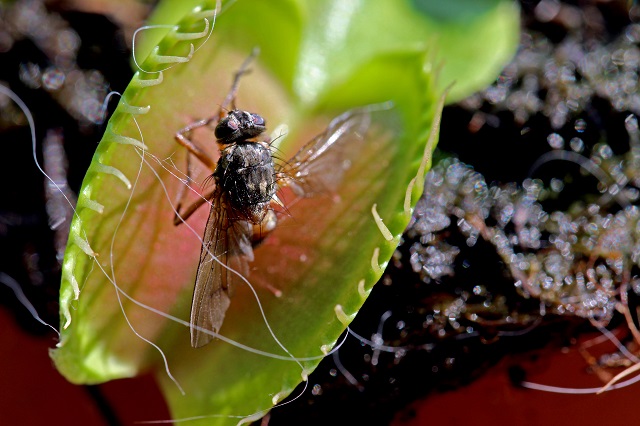Yes, known for its carnivorous eating habits, the Venus flytrap is a flowering plant. Two hinged lobes are attached to each leaf’s tip, making up the “trap.”. The lobes are covered with hair-like projections called trichomes, which cause them to close when an insect touches them. In response to being touched, plants move in a nondirectional way, known as thigmonasty, closing the trap.
The trap will only shut after the trichomes have been stimulated multiple times in order to prevent the plant from wasting energy if no insects are inside the trap. Small bristles surround the hinged traps’ edges to prevent prey from escaping. When the trap shuts, these bristles lock together, so the prey cannot escape. It is one of the very few carnivorous plants that actively traps prey using motion to catch it in the wild.
How does the Venus Flytrap work?
Small white flowers appear at the tip of the plant’s erect stem 20–30 cm (8–12 inches) tall, which grows from a bulblike rootstock. Its leaves are 8–15 cm (3–6 inches) long, and the blades are hinged along the midline, allowing the two nearly circular lobes, which have pointy teeth along their margins, to fold together and encompass insects. Three sensitive hairs are located on each lobe, which is triggered by pressure applied to them.
When stimulated by prey, the lobes snap shut about half a second after being stimulated. Afterward, glands on the leaf surface release a red sap that digests the insect’s body, giving the leaf a red flowerlike appearance. The digestive process takes about ten days, after which the leaf reopens.
Traps on plants only have a limited life expectancy. Plant traps remain closed after every capture for a week and a half, preventing the plant from receiving additional nutrients. The plant’s trap permanently closes after half a dozen openings and closings. It will eventually turn black and fall off. Plants will continue to receive nutrients from the trap as long as it remains photosynthesizing, but they will not be able to capture unsuspecting insects.
Venus flytraps eat ants as their primary prey, but they also eat beetles, slugs, spiders, flies, and even small frogs. Though flytraps consume bugs for nutrition, they do more than that. Plants require water, Co2, and sunlight to survive. An insect’s diet merely supplements plants’ needs.
Venus Flytrap Habitat
The Venus flytrap inhabits longleaf pine habitats in two regions of the Carolinas – Coastal Plain and Sandhills. During the summer months on the Coastal Plain, Venus flytraps grow in wet sandy pine savannas and loamy pine savannas. Additionally, it grows in ecotones like the sand rims of Carolina bays, where wet savannas meet drier areas. Sites of this type are generally flat, with moist or wet soils for the majority of the year.
A few Forest remain in the Sandhills region. It consists of narrow, moist areas between stream head pocosins (evergreen shrub bogs that line small creeks at their headwaters). Often occurring in relatively steep places where clay soils force seepage water to the surface, sphagnous sandhill seeps are dominated by shrubs and herbs. Also, they are found along similar vegetational ecotones between the Sandhill seeps and the longleaf pine uplands. The soils in these areas are typically acidic and loamy.
The Venus flytrap is vulnerable to fire suppression, land conversion to agriculture, silviculture, logging, bedding, ditching, and draining as part of residential or commercial development. As a result of fire suppression, shrubs and trees invade the Venus flytrap habitat, and the habitat quality gradually declines. During a clear-cutting session, plants are physically destroyed. In contrast, ditching and draining can change the hydrology and cause the soil to become too dry for moisture-dependent plant-like Venus flytraps.
Road expansions and maintenance may threaten venus flytraps because they are lesser quality roadsides. Venus flytraps are also at risk from over-harvesting. Venus flytraps are also at risk from poaching, and recent theft cases seem to have increased. It is believed that Venus flytrap plants have been harvested from the wild for horticulture and pharmaceuticals over the years. In North Carolina, taking Venus flytrap plants is now a crime.

How Do Venus Fly Traps Reproduce?
The Venus flytrap reproduces like many other plants. It produces seeds when its flowers are pollinated. The seed matures after four to six weeks and becomes black and pear-shaped. New plants grow from these seeds.
In the soil, the roots of the Venus flytrap create a bulb root system. From the bulb will grow a new flytrap. The gardener can separate the two by cutting the roots connecting the new plant and bulb to the parent plant. Asexual reproduction is also possible with these flytraps.

